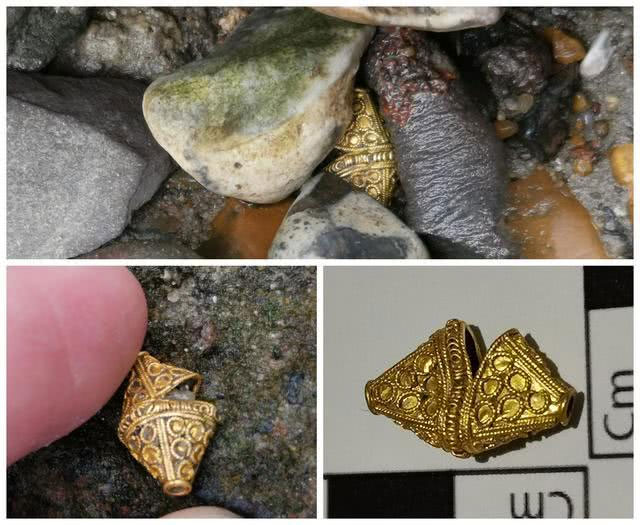The male worker changed his life after picking up a 1000-year-old jewelry
A worker walking during the lunch break discovered a piece of jewelry believed to be more than 1,000 years old and received over 3 billion VND.
A London worker walking the banks of the River Thames during lunch break discovered an Anglo Saxon-era piece of jewelry believed to be more than 1,000 years old.
Mateusz Adamchot (Polish) is walking in Battersea Park, southwest of London when he sees something small sparkling on the river. Upon closer inspection, he discovered a gold-like object covered in gold. The piece of jewelry is only 1cm in size, almost hidden among stones and pebbles.

The piece of jewelry is only 1cm in size, almost hidden among stones and pebbles.
Experts say the piece dates back more than 1,000 years to the Anglo Saxon era , according to a report from the Polish Scouting History website.
Mateusz sent photos of incredible medieval finds to the British Museum, where it was tested by their Mobile Antiquities Project. There, experts confirmed the piece of jewelry, which was adorned with elaborate small bracelets, most likely genuine.
Specialists will now conduct a more detailed inspection of this valuable item. The piece of jewelry has officially become the property of The Crown Royal Jewelery Museum, but after six months, Mateusz will probably receive a 100% value of the searcher's value, maybe over £ 100,000.
In 2014, an Anglo Saxon jewelry discovered by a historic student in Norwich was valued at £ 145,000.
Last year, a police officer was jailed for stealing a £ 150,000 Anglo Saxon coin he found with a metal detector.
Under the Treasure Act of 1996, prospective treasure seekers in England, Wales and Northern Ireland have a legal obligation to tell local investigators if they find anything.
"Treasures" may include any prehistoric object, gold or silver coins more than 300 years old or valuable objects deliberately concealed.

The piece of jewelry dates back more than 1,000 years before the Anglo Saxon period.
Coming from modern day Denmark and Germany, Anglo Saxons ruled most of England from the end of the Roman Empire around 400 BC, to the victory of Norman William the Conqueror in the Battle of Victory in 1066.
Saxon jewelry and art were popular throughout Europe at the time, and some of their gold treasures were found throughout Italy. The mass movement of medieval peoples is immensely popular, and many different cultures are disturbed and disturbed. One of the important revelations was that King Anglo Saxon Offa had coins with Arabic words written on it with the statement "There is no God but only Allah".
- Practically dig up 4300-year-old gold jewelry
- 50,000 year old jewelry made from ostrich eggshell
- Finding gold jewelry 13 centuries ago
- Since ancient times, why do people wear jewelry?
- Silently death from jewelry
- Jewelry picked up from Titanic was first displayed
- Special sex life of panda
- Guide rituals to worship on New Year's Eve
- Serious warnings about Ocean life
- Ancient Egyptians made jewelry from meteorites
- A 2,000-year-old tomb of a woman wearing precious jewelry
- The reason should wear silver jewelry
 Discovered an ancient centipede fossil 99 million years old
Discovered an ancient centipede fossil 99 million years old Discovered bat-like dinosaurs in China
Discovered bat-like dinosaurs in China Discovered a 200-year-old bronze cannon of the coast
Discovered a 200-year-old bronze cannon of the coast Discover 305 million-year-old spider fossils
Discover 305 million-year-old spider fossils